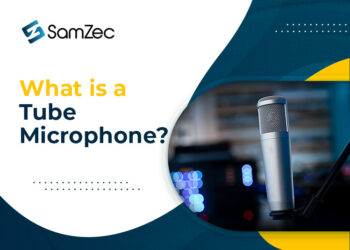Ribbon microphones are devices that capture sound and amplify it. They are often used in recording studios, theatres, and churches because of their clear and crisp sound quality.
Ribbon microphones differ from other microphones because they don’t use electromagnetic properties to function. Instead, they rely on pressure to create the sound waves we hear, known as a compression ribbon or an electromagnetic diaphragm.
How does the ribbon microphone work?
Ribbon microphones are made without any active electronics (they are passive). Inside each ribbon is a thin, flexible, pure aluminum or silver ribbon. When sound waves hit the ribbon, it vibrates. The ribbon is attached to two wires that go to the output.
The wires are routed through the magnetic field from the permanent magnet to generate the current needed to power the mic. The sound vibrations make the ribbon move, which changes the magnetic field, which causes the electric current to vary.
The varying current is sent through the wire attached to the permanent magnet, and it moves in a direction opposite to the current. The moving magnet and current create a small electric field (EMF – electromagnetic force) and a varying magnetic field.
These fields are what move the membrane and make the sound output. The amount of movement and the distance the membrane is pushed depends on the strength of the magnetic field. The ribbon microphone is a specific device with no electronics in it.
Different Types of Ribbon Microphones
There are also two types of ribbon microphones. The single- and dual-ribbon microphones. Single-ribbon microphones are the traditional kind of ribbon microphones. Dual-ribbon microphones are similar but have two ribbon elements side by side. It lets you cover a more extensive frequency range. The width of the ribbon in the microphone is also an important aspect. This aspect determines the frequency response.
How to connect a ribbon microphone to your computer
If you want to connect your ribbon microphone to your computer, you’ll first need to ensure you have the right equipment. Most ribbon microphones connect via XLR cables, which is the standard for professional audio.
There are also pre-amps or audio interfaces (a pre-amp and a headphone jack in one) that can be purchased if you do not have one. Plug the three-prong end of your XLR cable into the ribbon’s output and connect the other end to your interface. Then, connect your interface to your PC via USB.
Conclusion:
A ribbon microphone is a type of microphone that captures sound using a narrow ribbon or diaphragm. These mics are prized for their high fidelity or high-quality sound reproduction, mainly due to their large diaphragm. There are several different types of ribbon microphones, and they can be used on a variety of other instruments and in various applications.
FAQs
What is the ribbon mic used for?
Ribbon microphones are mainly used for recording vocals and instruments in high-quality studio situations. Good ribbon microphones are very quiet and generally have a warmer sound than most capacitor microphones.
Why is it called a ribbon microphone?
A ribbon microphone is called a ribbon microphone because of its type of pick-up transducer. The transducer, or microphone element, looks very much like a thin ribbon of metal. The microphone’s ribbon is a fragile, light magnetic material. The ribbon is suspended in a magnetic field and moves in response to sound waves. The ribbon is attached to an amplifier, which amplifies the sound.
Are ribbon mics good for bass?
Ribbon microphones are very good at reproducing bass. They are the most suitable for the boss. However, they are pricey. You could always use a dynamic microphone with the cardioid polar pattern and some proximity effect. But I would recommend using a condenser microphone (for example, Rode NTK), an excellent all-rounder.




















